Hello and welcome to ‘Focused on Feld’. In my Focused on Feld series of reviews, I am working my way through Stefan Feld’s entire catalogue. Over the years, I have hunted down and collected every title he has ever put out. Needless to say, I’m a fan of his work. I’m such a fan, in fact, that when I noticed there were no active Stefan Feld fan groups on Facebook, I created one of my own.
Today we’re going to talk about 2018’s Carpe Diem, his 28th game.

At its heart, Carpe Diem is a tile laying game. In Carpe Diem players will select tiles from a display and place them into their city district in order to score points and gather the resources needed to complete goals to score even more points. Stefan Feld’s no stranger when it comes to tile laying games, with games like Amerigo and The Castles of Burgundy under his belt. And he definitely isn’t new to giving players endless ways to score lots of points. In fact, that’s kind of what he’s known for. Carpe Diem brilliantly blends the tile laying elements with a variable scoring system similar to the one found in Isle of Skye or Cartographers, but does it in a way that’s fresh and unique.
Overview
In Carpe Diem, each player is given their own unique player board that’s divided into a grid. The grid is surrounded by a randomly constructed frame that depicts a different scoring criteria on each edge. In between the players lies a central game board which is divided into several areas that serve different functions. One area is populated with randomly selected scoring cards at the beginning of the game. Another contains the tile depots that the players will be taking the tiles from. At the top of the board is the banderole track (the little scroll icons); players score points as they move along the track and it also determines turn order. The remainder of this board contains reminders for end of game scoring and what each building in the game does.
On a player’s turn, they will move their pawn to a new depot, take a tile from that depot, and then add it to their city district. The goal of this action is to complete structures that allow you to collect the resources they produce (which will be used in the scoring phase). The scoring phase occurs once the depots have all been emptied. In turn order, each player will place one of their scoring markers at the intersection of two scoring cards and then score both of them. After four rounds, whoever has managed to score the most points wins the game.
This is a very high level overview of how Carpe Diem is played. You can continue reading if you’d like to dig more into how the game is played or you can skip right ahead to the Thoughts section to see what I think of the game.
Setup
First, the game board is set between the players. The left side of this board is populated with a random selection of scoring cards (the different types, total amounts of each type, as well as the layout are determined by player count). The right side of the board is filled with tiles drawn from the tile bag. There will always be four tiles per depot. Beneath these are placed a series of randomly selected dark green backed tiles (these tiles normally aren’t introduced until the fourth round).
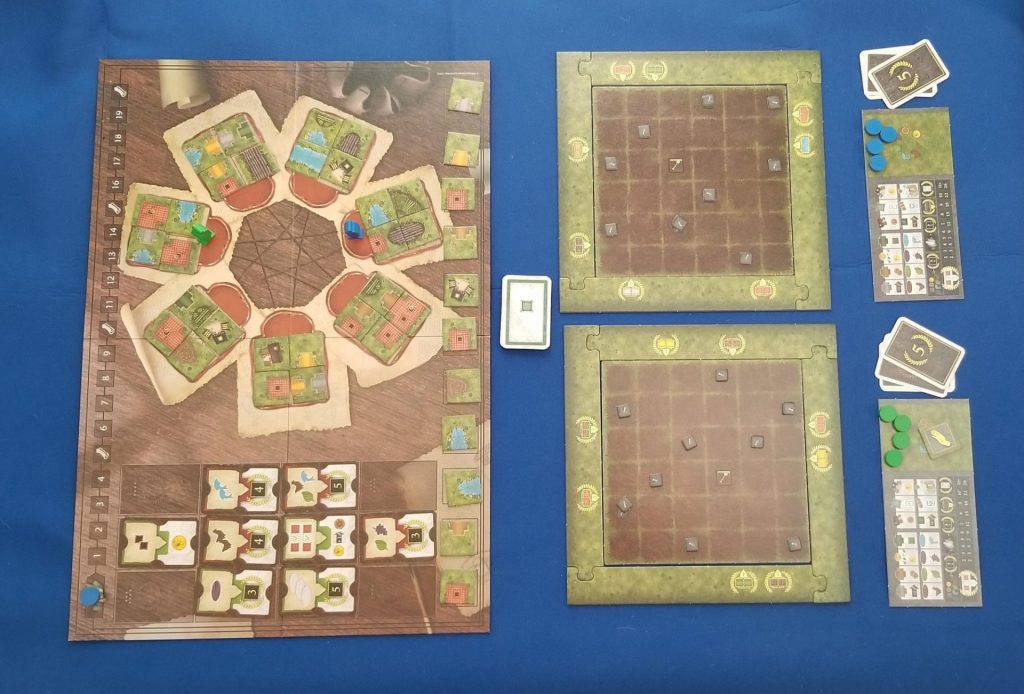
Next, each player is given a player board along with 4 randomly selected frame pieces which are assembled into a frame around the player board (called a “city district”). The pre-printed banderoles on this board are covered with banderole tokens. Each player will also receive several discs of their chosen color (one of which is placed on the 0 position of the banderole track) as well as a player pawn, which is placed into a starting position alongside one of the depots. A start player is determined and each player will receive some starting victory point cards depending upon their position in the turn order.
Now you’re ready to begin playing Carpe Diem.
A Round of Play
Even though Carpe Diem may look complicated, the actual mechanics of playing the game are very easy. Beginning with the start player, each player is going to move their pawn either one depot to the left or one to the right and then take a tile from the depot they wind up on*. This chosen tile is placed into the player’s city district making sure that each side matches up with whatever it’s touching. If this placement completes a building, then the player will perform the building’s action. If a banderole token is covered, the token is removed by the player and they move their disc one spot along the banderole track. Then it’s the next player’s turn.

Once each player has selected a tile and added it to their city district, play returns to the start player and the cycle begins anew. Once a depot is down to a certain number of tiles (determined by player count) the tiles remaining in that depot are removed from the game. The round comes to an end once all of the depots are emptied and then an end of round scoring is performed. After scoring the start player token is passed to the left and a new round begins.
*NOTE: This pawn movement described here is from the second edition. The first edition, pictured above, features a star shape between the depots and the players move their pawns along those lines. Alternatively, they can ignore the star pattern and just pretend there’s a circle instead.
The Buildings and Fields
Before we delve into the scoring, let’s take a moment to talk about what the different buildings and fields do. With the exception of the bakery, the gold mine, and the fountain, I’m going to refer to these by their color rather than their names.
Buildings
Silver: moves the player’s disc 2 spaces along the banderole track
Brown: earns the player two pieces of bread
Gold: the player trades in all of their collected resources for gold coins and receives one additional gold coin on top of that
Dark green: allows the player to take one of the dark green tiles from the board and add it to their city district

Bakery: the player receives a single bread
Fountain: the player receives a fountain card (which we’ll discuss in the scoring section)
Gold Mine: the player receives a single gold

Fields
Brown, green, purple, blue: rewards the player with a number of chickens, herbs, grapes, or fish. The longer the completed building, the more resources it earns.

Villas
Red brick: this is a portion of a villa. The importance of villas will be discussed in the scoring section.
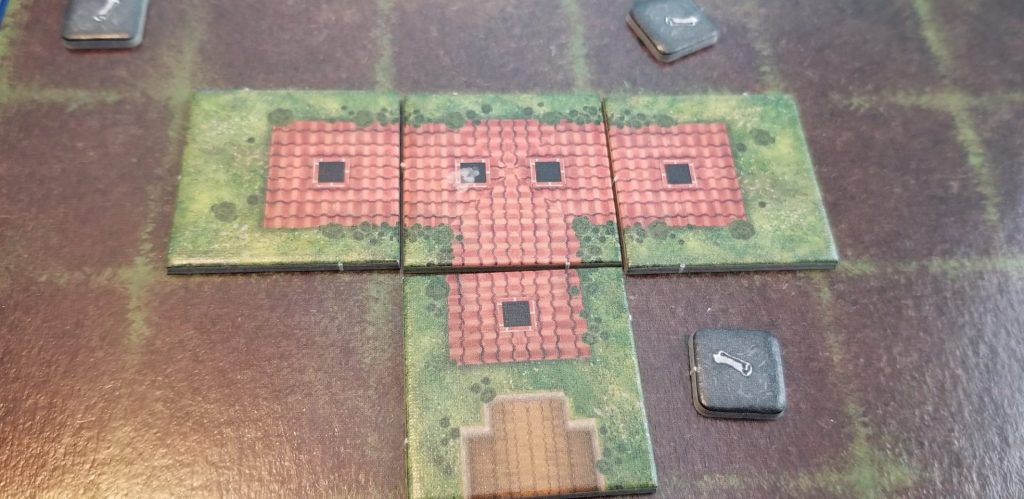
Gold can be used as a stand-in for any one resource during scoring, so it’s good to have. Bread has two different functions: a single piece of bread can be used to allow a player to move to any depot of their choice (or just remain where they are) OR three pieces of bread can be used during a scoring round to meet all of the criteria of a scoring card without having to spend any actual resources to do so.
End of Round Scoring
End of round scoring occurs, you guessed it, at the end of each round. Beginning with the person furthest along the banderole track, each player will place one of their discs at the intersection of two different cards and then attempt to score each of them in the order of their choosing. The proceeds from one card (provided there are any) can be used in the scoring of the other one. However, for each card that the player is not able to score, they will lose four victory points.

These score cards come in several varieties. Some score points for turning in specific collections of resources. Some score points for meeting certain criteria (having several completed buildings, for example). Others may not score points at all, but may reward you with resources if you’re able to meet the card’s criteria (receiving a gold piece for every two chimneys present on your villas, for example).
Here’s an example. Let’s imagine that the green player has chosen to place their discs on the two cards shown here:
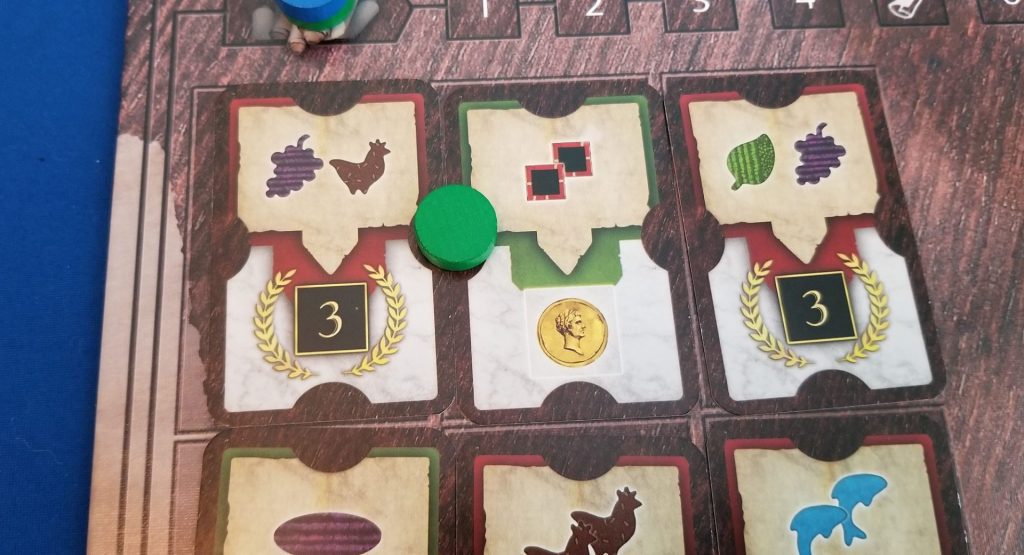
In this example, the card on the left will reward the player with three points for each collection of one grape and one chicken that the player is able to turn in. The card on the right rewards the player with one gold for every two chimneys. Even if the player does not have a single grape or chicken in their supply, if they had at least four chimneys they would earn two gold from the rightmost card and could use that to score three points from the leftmost one. However, if the player does have a chicken and a grape as well as four chimneys, they could score the card on the right first earning them 2 gold. Then they could score the card on the left twice, using their chicken, their grape, and their two gold as stand-ins, to score 6 points.
End of Game Scoring
After the last end of round scoring is performed, end of game points are distributed. The bottom of the central game board contains a helpful reminder to show you how this scoring is performed.
Every two resources will be worth 1 point. The player scores points equal to their position on the banderole track. Then they score frame points. Frame points are awarded if the player was able to successfully build the structures pictured on the edge of the frame in the right position. Each frame scoring icon has a numbered shield whose tip points along a grid line. If the pictured building type straddles this line and is completed, the player will score points equal to the number on the shield. Each frame scoring criteria can only be scored a single time. Here’s an example:
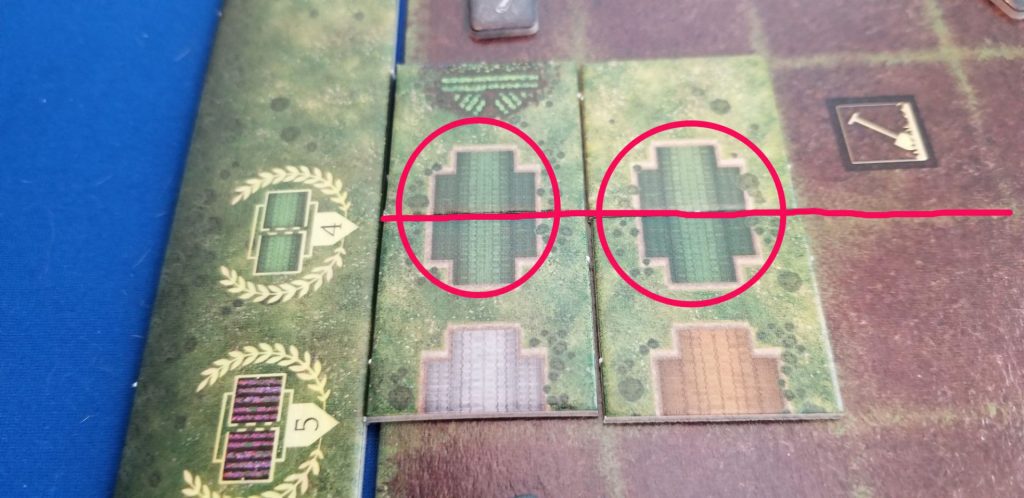
Next, fountain cards are scored. Each fountain card scores the player two points for every time that player has met the criteria on the card. For instance, a fountain card might score two points for every gold building a player has completed. So, if they have completed two of them, the card would be worth four points.
Finally, players score points for their completed villas based on the number of chimneys present in each separate one. A tiny villa with only two chimneys would only be worth a paltry two points, while a larger one could score them all the way up to 26 points!
After all of this, the player with the highest total score wins.
Thoughts
From a purely visual standpoint, Carpe Diem isn’t going to be winning any awards any time soon. It’s as if the artist asked themselves “Why is Castles of Burgundy universally panned for its appearance and how can I take that, incorporate it here, and somehow make it even worse?” Not only are the colors in Carpe Diem taken from that same muted dark green and maroon palette, but there are colors that are so similar under low lighting conditions that it’s almost impossible to tell them apart. This seems to be a common feature of many eurogames. Aside from its appearance, my only other complaint would be the victory point cards. I don’t understand why the decision was made to track victory point totals using a pile of fiddly cards when a score track would have been a much more elegant and easy to use solution.
Those nitpicky things aside, Stefan Feld has created a masterpiece.
The genius of Carpe Diem lies in the scoring cards and how their existence shapes the decisions you make in the game. In games like Isle of Skye or Cartographers, you know when each of the different scoring criteria will activate and can work towards setting yourself up for that eventuality. Everybody is affected equally, even though some may capitalize on the scoring opportunities better than others.
However, in Carpe Diem, even though the scoring cards are open information, if someone else gets to them before you they might take the position that you were hoping for, forcing you to settle for something suboptimal. This presents a lot of interesting quandaries. Do you try to collect a little bit of everything so that you can at least score something or do you hit the banderole track hard so that you can be sure that you’ll get what you want? Or maybe you should ignore the scoring cards entirely and focus on getting your points elsewhere. After all, what’s the loss of 8 points if you’re gaining 26 somewhere else?
Even the tile selection process presents strategic opportunities. Should you take the tile you need to finish one of your buildings OR do you take that tile over there just so that one of your opponents doesn’t get their hands on it (even though it doesn’t necessarily benefit you)? Carpe Diem’s the type of game where it behooves you to try and keep track of what your opponents are doing, what resources they have on hand, and what scoring cards you think they’re likely to go after because this game’s as much about hampering your competition as it is about ensuring your own success.
Carpe Diem is a damn fine game. The easy to understand game play coupled with the interesting puzzle it presents make it a game worth owning and playing. If you’re the “try it before you buy it” type of person, head over to Yucata (a collection of digital board games) where they recently added Carpe Diem to their lineup of games and give it a try!


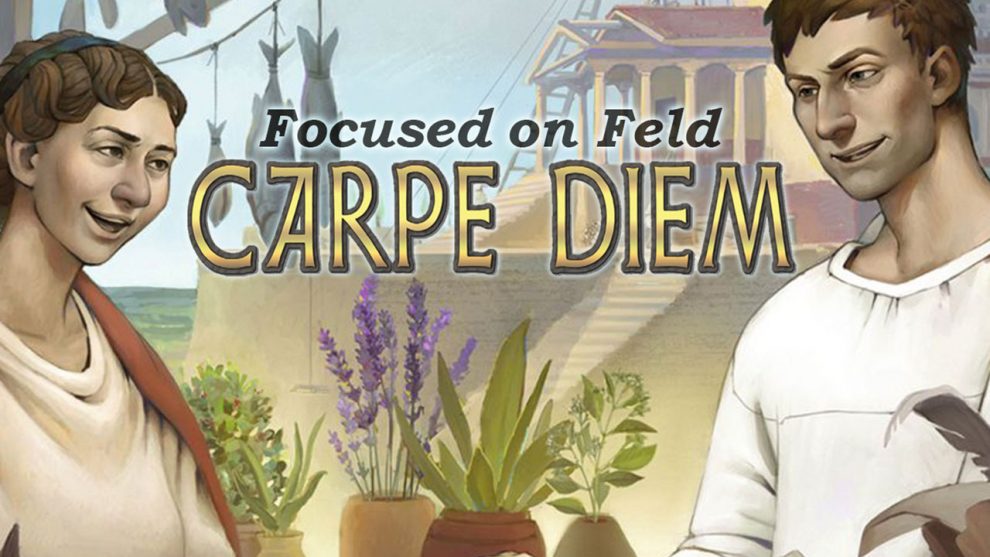

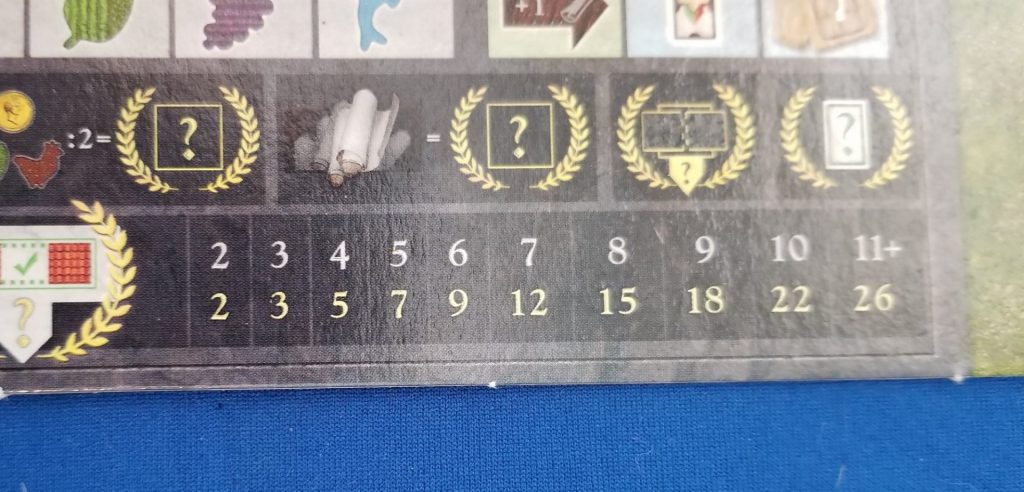








Add Comment